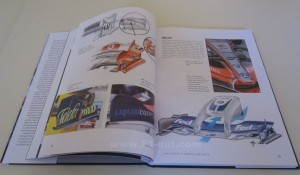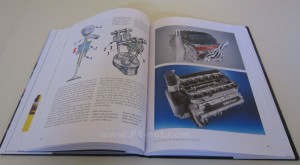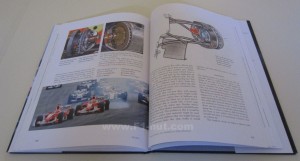
Book Review: The Science of Formula 1 Design by David Tremayne


:
Positives
Negatives
Since we’re still in the pre-season testing period, its makes sense to review a book on F1 car design. I have a copy of the 2nd edition of David Tremayne’s “The Science of Formula 1 Design” published in 2006 (with the Toyota TF106 on the cover) which covers all the design areas of modern F1 cars without too much technical mumbo jumbo for the reader. Note: A 3rd edition was later published in 2009 (with the Webber Red Bull RB5 on the cover) which updated the book for the 2009 regulation changes. I haven’t had a chance to look at the 3rd edition but if its an enhanced version of the 2nd edition, it should be pretty good too.
The Science of Formula 1 Design is slightly different from a lot of the mainstream F1 books because it focuses entirely on the design process of producing F1 cars. There have been other similar books published in the past, like the Autocourse series – “Technology of the F1 Car”, Alan Henry’s “Quest for Speed“ and the much more technically oriented “Formula 1 Technology” by Peter G. Wright. David Tremayne’s book is more accessible to the layman F1 fan and is supplemented by better photos and diagrams than books of the past.
Each of the 11 chapters deals with a design aspect from aerodynamics, chassis construction, engine, transmission, electronics, suspension and steering, brakes, tyres, technology advancements in materials and the political influence of FIA administrators and team technical bosses. There is also one section dedicated to explaining the FIA’s monocoque crash testing procedure which is probably the most technical section of the whole book.
Being the 2nd edition, much of the book’s content deals with 2005-6 regulations – for example, the chapter on tyres, goes into a lot of depth on the technical aspects of grooved tyres and of course, talks about the disastrous Michelin tyre debacle in the 2005 US Indianapolis GP.
There are plenty of color photos of Sauber’s wind tunnel, Renault’s autoclave, engine exhausts, front and rear suspensions, brake assemblies and Michelin tyres.
There is also a useful short technical glossary at the rear which helps to complete this book as a concise reference text. Make no mistake, its not as technically deep or detailed as Peter Wright’s book but it is a good introductory book for the average F1 fan.
Wow factor or Money shot: If you’re a fan of Giorgio Piola’s technical diagrams, there are plenty of samples in this book.
Suitable for: F1 fans with a passing interest in the technical design side of things.




























Good post. Ive just forwarded the link to my coworker|.